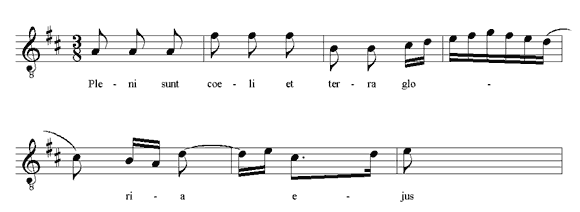Six of Bach’s motets (BWV 225-230) survive, all from his time in Leipzig. These are long works, far longer than the Renaissance ancestor of this genre. Four, including Singet dem Herrn, were written for double chorus without instrumental accompaniment, although in Bach’s day he sometimes doubled the voices with instruments for additional support. (Instrumental parts in Bach’s hand do survive, but Bach himself indicated that he preferred to use them only as a “crutch.”)
Singet dem Herrn was likely written in 1727 for the Leipzig city and university festival celebrating the birthday of King August, who visited the town after having survived a grave illness. There is, however, a good deal of dispute over the original intention for the work,a well as for the actual date of origin. Handwriting analysis (by Alfred Dürr) reveals that the work clearly comes from 1726 or 1727. The watermark on the paper, however, is consistent with those seen on Bach’s Cöthen instrumental music, which makes scholars wonder whether Bach actually wrote the work earlier, or whether the paper was simply left over from an earlier time.
Scholar Steven Daw places the work in late 1727. Daw believes that Bach wrote Singet dem Herrn for a memorial service for the Queen of Poland. Awfully cheerful piece for such an occasion? Yes, but consider the circumstances of her life: she spent the last thirty years of her life in exile from the Polish court after she, unlike her husband, refused to renounce Lutheranism for Roman Catholicism. She was seen by many German Protestants – Bach included – as a Lutheran martyr. Bach’s use of a chorale tune (the actual source is unknown) may be the hint here, as well as his insistent repetition of the words “Wohl dem, der sich nur steif und fest auf dich und deine Huld verlässt” (happy the man who firmly and steadfastly puts his trust in You and in Your grace). Is this a message for the congregation to follow the queen’s lead? Of course, we might still see this as Bach’s personal message. Whether the motet was written in celebration of the King’s recover, the Queen’s steadfast belief in the Lord, or some other even unknown to modern audiences, Bach’s own unflappable faith is evident in that text, and throughout the entire motet.
The text for Singet dem Herrn is derived from Psalm 149, Psalm 150, and Johann Gramann’s hymn “Nun lob, mein Seel, den Herren”. Bach divides the motet into four clear sections.
The first is vigorous, and clearly focuses on the world “singet”, stating it more than 50 times. The multiple repetitions of this word, the energetic rhythms, and the use of the two choirs independent of each other create the feeling of singing echoing throughout the world in praise of the Lord. There are wonderful moments of word painting here, most notably:
- the long active melisma on “Reigen” (dance)
- the many repetitions of “singet”, which constantly create the feeling of the start of a new song (get it? sing a new song…), and
- the timpani-like movement through a triad on “Pauken” (drums) amidst otherwise flowing music.
Another interesting musical twist gets somewhat lost in the shuffle, so to speak; this is the fugue on “die Kinder Zions sei’n fröhlich über ihren König,” which begins in choir one (SATB entrances) while choir two returns to the opening material. After a time, the two choirs switch roles, with the fugue beginning again in choir two, this time in reverse order of voices (BTAS).
The second section is reflective. The two choirs are still treated as independent entities, but choir two takes on a distinct character, performing a chorale. Although I don’t know exactly the source, it reminds me very much of the famous setting of Psalm 100, known as “Old Hundredth” or “Praise God from Whom All Blessings Flow.” Here are both:


(In Singet, Bach actually wrote a measure rest between the two phrases, where Choir one sings, but I took that out here so you could see the similarity in the chorales.)
This chorale melody is presented by choir two homophonically, alternating with choir one, which sings a completely different text, melody, and texture.
The third section is spirited and dance-like; here, the two choirs are used antiphonally, with the second choir imitating the first.
The final part is a mighty four-voice fugue (so the two choirs sing as one), which is closely related to the fugue in the Sanctus (“Pleni sunt coeli”) of the Mass in B Minor. As a comparison, let’s see these two fugue subjects side by side:


Both are in 3/8 meter; both contain sixteenth-note melismas; both use some syncopation; and both create a lively, festive mood.
Wolfgang Amadeus Mozart was reportedly deeply moved when he heard a performance of this work in 1789, so much so that he requested permission to see the music and proceeded to copy out the parts. Could this have been the inspiration for some of the grand fugues that appear in Mozart’s late works, for example, the Requiem and final movement of Symphony No. 41 in C Major? One can only wonder.










































